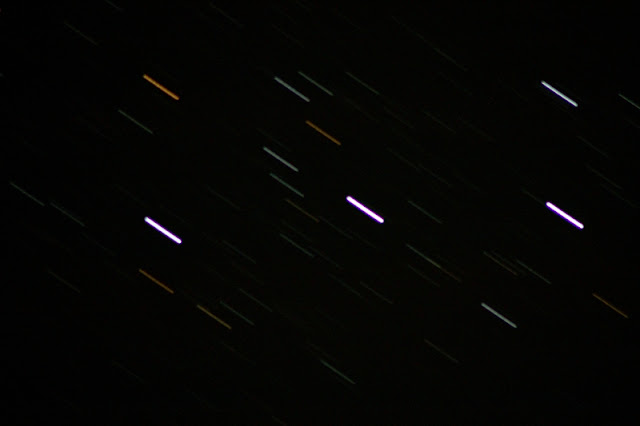Idea is to have very very slow shutter speed ie keep the shutter of camera open for a long time. During which, earth rotates (or stars "move"); hence the stars and other bright objects in the sky make bright lines in the pic rather than shiny dots.
Can you believe this was shot pitch dark night ?
Can you believe this was shot pitch dark night ?
 |
From StarTrails Exposure: 6019.0 sec |
How ever the dark the sky looks, there is always light, from near by street lamp, distant house, street lights and thousand other things that emit light. Hence it is good to try long exposure shots of night sky in remote places where light pollution is minimal.
On December and January night sky, the most famous and noticeable constellation is the Orion Constellation. That's what I tried capturing during all my efforts this time.
Exposure : 310.0 sec |
As you can see above, instead of black background I have somewhat of a reddish color, purely because of all my neighbors not switching off their house lights :-)
Wide angle is the best option to cover as much area as possible. Also you would need tripod to mount the camera.
In Shutter priority mode, camera usually allows only 30 seconds of exposure. So switch to manual mode, keep decreasing the shutter speed and you would hit some thing called bulb-mode.
I have recently bought the remote trigger for my camera and it made my job of clicking photo easy. Either remote or some other method for keeping the shutter release button pressed.
Another thing to note, its almost guaranteed that auto-focus will not work with faint brightness of stars, hence you would have to switch to manual focus.
Here is an example of my myopic eye-sight fooling me :-(
Exposure : 68.0 sec |
Exposure time of more than few hours is very common. But usually pictures will be shot with shorter duration and then will be stacked to reduce the light noise.
One more problem I faced: since the lens is pointing towards sky, there will be mist / moisture that gets collected on the lens. It slowly blurs the pic. I have not found any solution for this yet. methinks I can wipe the moisture off in the middle of long exposure. Not sure though.
Here is an example : Star trails are looking like they are comets !!
Exposure : 1863.0 sec |
Its not the first time I tried the star trail photography, and its always fun.
This pic I took in early 2009 :
For a change this time I went to sea shore one night, hoping to see less light. But there wasn't much difference in light pollution though :-(
Here is a better shot I have :
Exposure: 1800.0 sec |
One thing that you definitely need is patience, loads of patience :-)
Now, go on, shoot some stars :P







No comments:
Post a Comment